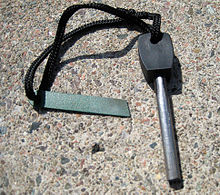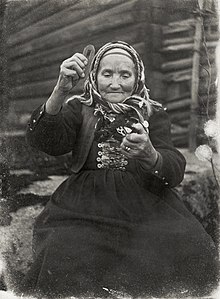Fire steel

The fire steel (also fire hammer , punch ; out of date: fire iron , fire scraper , pink iron ) consists of a carbon-rich (approx. 0.7–1.4% C) steel and is an indispensable part of the so-called punch lighter .
Modern fire steels consist of Auermetall III, an alloy of iron , cerium and other rare earth metals.
use
A strike lighter consists of a fire stone (also fire hammer) as a spark remover, a fire steel as a spark dispenser and tinder as a spark receiver. The fire steel is struck against the sharp edge of a hard piece of rock, usually flint. The sharp counterpart scrapes material from the fire steel, which immediately ignites to sparks due to the friction , the temperature of which can reach 1500 ° C. These are caught on tinder, such as fire sponge or fabric tinder (charred cotton fabric), which is then set in embers.
The glowing tinder is then placed in a tinder nest. A flame is then lit by supplying air .
history
In European prehistory, pebbles are the only sparking material. In the early Roman times at the latest, it was replaced by iron, which has since served as a central component of punch lighters.
Even the earliest fire steels had a classic functional form that, with slight modifications, persisted well into the 20th century. They usually consist of a rectangular steel rail, which is forged thin and long at one or both ends to form one or two “arms”. The arm or arms have a curved loop shape and approach or touch the back of the steel rail. "Two-arm steels" have undergone numerous modifications in shape and dimensions over the course of time.
A recent metallurgical analysis of a supposed Roman so-called strip steel has shown that it is not made of carburized and therefore high-carbon steel, but of soft forged steel. A subsequent intentional or accidental change in the metal structure ( tempering ) could also be ruled out. Due to the low thickness of the steel strips, which are also known from pre-Roman times, this result can generally be transferred to this type of device. It is therefore certain that pre-Roman and Roman steel strips could not produce sparks and therefore did not serve as fire steels, although the shape is similar to the medieval finds and leads to the assumption. At the same time, this means that the function of the objects, also known as "double loops", is still unknown.
Impact steel lighters were the European standard lighters and can be safely verified from the earliest Roman times to modern times . Even after real matches were launched on the market in 1827, punched steel lighters were still used in Europe well into the 20th century due to their lower price, especially in rural areas for making fires.
heraldry
In heraldry , the depiction of the fire steel is a rare common figure .
literature
- S. Bois: Le briquet médiéval. Silex et acier, une rencontre étincelante. Éditions Émotion Primitive, Fontaine 2008
- HA Brunner: fire and fire knives . Stuttgart / Vienna 1998.
- V. Cacciandra, A. Cesati: Fire Steels . Turin 1996.
- P. De Sanctis, M. Fantoni: Gli Acciarini - Fire Steel. Itinerari d'immagini 38 . Milan 1991.
- E. Fehre: Arsonist. A little history of the lighter. Leader of the Lower Rhine. Mus. for folklore u. Cultural history. 42 Goch, 2002.
- J. Hála: 1986: Archaic methods for lighting fire in the Carpathian Basin with special regard to the use of siliceous materials in: KT Biró (Org.) International conference on silex extraction and stone tool raw material characterization in the Carpathian Basin. Budapest-Sümeg, May 20-22, 1986, pp. 323-342
- J. Ilkjær: Keyword 'lighter' . In: Reallexikon der Germanischen Altertumskunde 8 Berlin 1993, pp. 406–408
- Ottfried Neubecker, Karl-August Wirth: Feuerstahl , in: Reallexikon zur Deutschen Kunstgeschichte , Vol. 8, 1983, Sp. 498-521
- B. Roussel: La Production du feu par percussion de la pierre. Préhistoire, ethnography, experimentation. Prehistoires 11 . Montpellier 2005.
- B. Roussel, S. Rapior, C.-L. Masson, P. Boutié: l'Amadouvier. Grande et petite histoire d'un champion. Supplement hors-serie des annales de la Soc. d'Horticulture et d'Histoire Naturelle de l'Hérault . Montpellier 2002.
- B. Roussel, P. Boutié: La production du feu durant l'Antiquité classique in: Le Bulletin d'Ethno-Logique . 2005. pp. 21-27
- B. Roussel, P. Boutié: La Grande Aventure du Feu. Histoire de l'allumage du feu des origines à nos jours . Aix-en-Provence 2006.
- F. Seeberger: For the identification of fire steels . In: Archäologisches Korrespondenzblatt 15 . 1985, pp. 257-259
- M. Skiljan: Metallica. Hrvatski Povijesni Muzej . Zagreb 2002.
- H. Steuer: Keyword lighter ' . In: Reallexikon der Germanischen Altertumskunde 8 Berlin 1993, pp. 402–406 and 408–411
- W. Wegewitz: The urn cemetery of Hamburg Marmstorf . (Urn cemeteries in Lower Saxony; 7). Hildesheim 1964
- J. Weiner: With steel, stone and tinder. The forgotten technique of beating fire . In: Pulheimer Contributions to History and Local History 5 1981, pp. 13-18
- J. Weiner: `Gedum` - fire steel or multifunctional tool of early muzzle loaders? . In: Ethnographisch-Archäologische Zeitschrift 37, 1 1996, pp. 47–57
- J. Weiner: `Gedum` - fire steel or multifunctional tool of early muzzle loaders? An addendum . In: Ethnographisch-Archäologische Zeitschrift 40 1999, pp. 417–447
- J. Weiner: monopoly of humanity. Focus on fire . In: Archeology in Germany, Issue 4 Stuttgart 2006 (pages 28–31)
- J. Weiner: An Unknown Type of Fire Steel from Iran . In: The Journal of the Antique Metalware Society 15 . 2007 (pages 58-60).
- J. Weiner, R. Hertel: Inconspicuous and yet extremely rare: an early form rifle key from Jülich . In: Archeology in the Rhineland 2007 Stuttgart 2008, p. 160 f.
Web links
- Archaeological Lexicon: The Blow Lighter
- Wolfgang Zessin: On the typology of the fire beaters (PDF download; 1.0 MB)
Individual evidence
- ↑ a b c Jürgen Weiner: Fire stones and fire generation . In: Harald Floss (Hrsg.): Stone artifacts from the Old Palaeolithic to the modern age . Tübingen 2012, p. 943-960 ( online [accessed May 8, 2019]).
- ↑ Ruth M. Hirschberg: Making fire with iron and tinder. Retrieved September 1, 2016 .
- ↑ Jürgen Weiner: Again to early fire beams - To the surprising clarification of a hypothesis . In: Research on prehistory and Roman times in the Rhineland . 2007, p. 269-276 ( online [accessed May 8, 2019]).
- ↑ Wolfgang Gaitzsch , Jürgen Weiner: Two remarkable iron finds from villa rustica Hambach 488 . In: Archeology in the Rhineland . 2006, p. 151-152 .
- ↑ J. Tinnes, Jürgen Weiner: A Roman Firesteel from Frixheim . In: Archeology in the Rhineland . 2003, p. 124 f .
- ↑ Jürgen Weiner: Collector's instinct and collector's luck: A fire steel from the Western Sahara . In: Spark International . No. 13 , 2000, pp. 8-16 .


